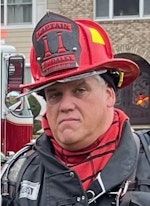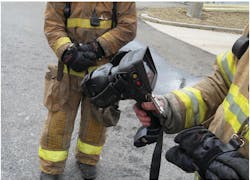Thermal Imaging Cameras for Incident Commanders
Editor's Note: Mike Daley will be presenting "Thermal Imaging Cameras For Strategic Decision-Making" at Firehouse World in San Diego, Jan. 25-29. a6566
There are a ton of factors to consider when determining an action plan at a structure fire, so it is imperative to gather enough information to make the right call on a mode of operation. During the 360 size-up, clues surrounding the exterior of the structure help to make an attack plan, but to get a complete picture, the efficient incident commander (IC) needs to see what’s going on inside the structure. It may take some time to get an initial crew assembled to retrieve that information; time can be saved by performing the size-up with a thermal imaging camera (TIC) (see Photo 1).
Thermal Imaging 101
The inception of thermal imaging usage for firefighting began with the Royal Navy/Shipboard firefighting. It was this application that started the use of thermal imaging within the fire service, and it migrated to land based units. The concept was this: All objects have a certain temperature and emit waves of energy called infrared radiation (IR). Now, for most of us in the fire service, we are what I like to refer to as “End Users”; we want fast, accurate results, and, for the most part, we don’t care how we get them. However, as a culture, we should have a better understanding of how these results are obtained. So, here is the simple version: Hot objects will emit a higher amount of energy than cold objects; a thermal imager translates these energy levels into a viewable image, which shows a “heat picture” of a scene (see Photo 2). On the screen of the TIC without color, hotter objects are whiter, cooler objects are black and those in between vary in shades of gray. Because the IR radiation is not blocked by smoke, the TIC is a useful tool by firefighters to find victims, locate the seat of a fire and catch structural hazards earlier in the incident, lowering the risk level of interior fireground operations. Seems simple, but there is a bit more to it for the end users to grasp when it comes to TICs.
For example, how much does the average “firefighter” know about fire behavior? In my home state, the entry level “Firefighter I” class is more than 160 hours, with only three hours devoted specifically to fire behavior. Firefighter II is more than 110 hours with no specific fire behavior training. Fire Officer I and II: 108 hours, no fire behavior training. So when it is totaled up, the amount of true formal fire behavior training the average firefighter gets is less than 1%...and the absolute definition of our profession means that we are “experts” with fire…but are we?
Our neighborhoods are becoming inundated with larger, elaborate residential dwellings, all featuring large open spaces, multiple void spaces, increasing fuel loads and lightweight building materials. Each one of these factors has led to faster fire propagation, shorter time periods before flashover conditions, rapid changes in fire dynamics, and much shorter times to total building collapses. In short, we are experiencing volatile fireground behavior in disposable buildings. Having the TIC during the size-up can help to spot these issues without committing troops into a position that can lead to disaster (see Photo 3).
Taking this into consideration, it is important to understand what the TIC is telling you. This poses a significant risk to firefighters, because if the IC does not understand exactly what the picture is telling them, then there is a tactical decision being made without all of the facts! There are some basic rules on how the TIC operates:
Rule#1: Cameras measure contrast: Contrast is based upon the difference in temperatures within the objects the TIC sees. Remember that many materials within a structure fire have different levels of density, which will allow these materials to absorb and retain heat at differing rates.
Rule #2: Cameras are at the mercy of the environment: There poses a significant risk to firefighters when technology is introduced to the fire service and proper training is not offered to coincide with its use; it will lead to significant injury and potential death (see Photo 4). Basically, if you don’t understand exactly what the picture is telling you, then you may not be making a tactical decision with all of the facts!!!
Rule #3: Cameras are at the mercy of the interpreter: Thermal imagers do not interpret image results; they merely show the results on the screen. Therefore, it is up to the end user (firefighter/officer) to interpret the picture to set the right incident action plan (IAP) into play. Understand that not knowing what the image is telling you will lead to poor decision-making and possible injuries to the firefighters. To get the most bang for your buck, one must become an expert in the art of interpretation. Step one: Know your camera. Step two: practice, practice, practice! Take it off the rig at every call!
Rule #4: TICs do not make the firefighter invincible: While they are a great asset to the fire service, the camera cannot see through water, glass, walls, ceilings, clouds and steam. The firefighter must still rely on their training while operating within the danger area.
Size-Up & Command Applications
When TICs became available for the first-in companies, a large focus was placed on getting them into the hands of the search teams. After all, the TIC was going to help the crews “see” through the smoke and rescue the victim. But in reality, the TIC belongs in the hands of the first-arriving officer, already powered on so that it is ready for use once the officer steps out. The information provided by the TIC is critical for the initial size-up. First and foremost, identifying considerable fire behavior clues can increase responders’ safety. Most firefighters focus on the flames, and consider smoke secondary during size-up. When we consider smoke is raw fuel, when would we stop and consider a smoke condition a “no-go” event? What if the smoke was replaced with Natural Gas, would our strategies change? The bottom line is this: When materials within a compartment are heated, high temperatures can signal a possible dynamic event within the space (see Photo 5). So, when we train the TIC into the smoke column, what is the TIC telling you? Is it a “no-go” event? Knowing what that picture is telling you is first priority!
The officer should be taking the TIC during their 360-degree size-up to obtain a “thermal profile” of the compartment/structure. The TIC can aid in determining the spot of the most energy/heat release, so the first-arriving suppression teams can be directed to the best spot to start the operations. Additionally, this profile may be the deciding factor between offensive and defensive operations. For example, is it really “smoke showing”? It may look like smoke, but heat will be masked by smoke. The TIC is needed to make that decision.
Interior TIC operations do not stop at search. Your engine company stretches to the door of a residential structure fire with hot smoke showing at the door, moving outward at a good pace. Smoke is banked down close to the floor; which way to the fire, to the left or the right? The officer uses the TIC within the structure to follow the thermal contrast directly to the area of the seat of the fire (see Photo 6). Additionally, the TIC can help find pockets of hidden fire and heat travel within walls and void spaces. Without it, firefighters may not pick up on dangerous fire spread until it breaks out between them and the exit, placing them in extreme danger.
Viewing the existing products of combustion from the vent point can help determine if suppression techniques are sufficient and if the vent point is large enough to allow for the exchange of cooler air. If temperatures are not dropping, it may be time to adjust operations or increase the size of the vent opening. A word of caution about vertical vent points: take into consideration the radiant heat from the sun on the roof tiles and decking, as they might give a false sign of high temperatures under the roof, signaling an attic fire. Be sure to get under the roof for an accurate depiction of conditions.
Of all on-scene operations, the TIC has had the most drastic impact in the area of search and rescue. Without it, firefighters must rely on crawling on their hands and knees and grope around for a victim. Success rates this way are low, since we can only rely on physical contact to find a victim. In the search teams’ hands, rescuers can see the overall scene, allowing them to quickly identify and remove victims from harm (see Photo 7). Its usage doesn’t stop at structure fires; rescuers can scan the pile at a building collapse to find potential victims who may be missed with the naked eye. A person’s heat signature can be read by the imager, guiding rescuers to the victim’s location.
Conclusion
As an incident commander, it is paramount to have all of the information necessary to make a well-informed decision. Without a thermal profile of the incident, there is too much risk being taken when the facts can be within reach with the use of the TIC. Responders must become experts within the field of interpretation; Train with the camera as you would actually operate. Stretch in handlines, perform search and ventilation at your next live-burn training session, and see how the TIC can be adapted to suit your needs.
Until next time, stay focused and stay safe.
See Mike Live at Firehouse World: Mike Daley will be presenting "Thermal Imaging Cameras For Strategic Decision-Making" and "Communications Between the Front Seat and the Jump Seat" during Firehouse World in San Diego, Jan. 25-29. Find out more at FirehouseWorld.com.
MICHAEL P. DALEY is a lieutenant and training officer with the Monroe Township, NJ, Fire District No. 3, and is an instructor with the Middlesex County Fire Academy, where he is responsible for rescue training curriculum development. Mike has an extensive background in fire service operations and holds degrees in business management and public safety administration. He was named a Master Fire Instructor from the International Society of Fire Service Instructors. Mike serves as a rescue officer with the New Jersey Urban Search and Rescue Task Force 1 and is a managing member for Fire Service Performance Concepts, a consultant group that provides assistance and support to fire departments with their training programs and course development. You can reach Michael by e-mail at: [email protected].

Michael Daley
MICHAEL DALEY, who is a Firehouse contributing editor, is a 37-year veteran who serves as a captain and department training officer in Monroe Township, NJ. He is a staff instructor at multiple New Jersey fire academies and is an adjunct professor in the Fire Science Program at Middlesex County College. Daley is a nationally known instructor who has presented at multiple conferences, including Firehouse Expo and Firehouse World. His education includes accreditations as a Chief Training Officer and a Fire Investigator, and he completed the Craftsman Level of education with Project Kill the Flashover. Daley is a member of the Institution of Fire Engineers and a FEMA Instructor and Rescue Officer with NJ Urban Search and Rescue Task Force 1. He operates Fire Service Performance Concepts, which is a training and research firm that delivers and develops training courses in many fire service competencies.






